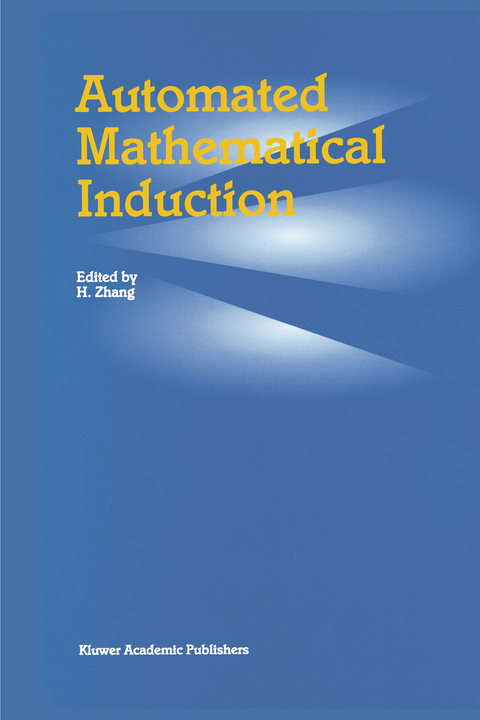
Automated Mathematical Induction
Seiten
1996
|
Reprinted from JOURNAL OF AUTOMATED REASONING 16:1-2, 1996, 1996
Springer (Verlag)
978-0-7923-4010-2 (ISBN)
Springer (Verlag)
978-0-7923-4010-2 (ISBN)
It has been shown how the common structure that defines a family of proofs can be expressed as a proof plan [5]. A proof plan has two complementary components: a proof method and a proof tactic. By prescribing the structure of a proof at the level of primitive inferences, a tactic [11] provides the guarantee part of the proof.
It has been shown how the common structure that defines a family of proofs can be expressed as a proof plan [5]. This common structure can be exploited in the search for particular proofs. A proof plan has two complementary components: a proof method and a proof tactic. By prescribing the structure of a proof at the level of primitive inferences, a tactic [11] provides the guarantee part of the proof. In contrast, a method provides a more declarative explanation of the proof by means of preconditions. Each method has associated effects. The execution of the effects simulates the application of the corresponding tactic. Theorem proving in the proof planning framework is a two-phase process: 1. Tactic construction is by a process of method composition: Given a goal, an applicable method is selected. The applicability of a method is determined by evaluating the method's preconditions. The method effects are then used to calculate subgoals. This process is applied recursively until no more subgoals remain. Because of the one-to-one correspondence between methods and tactics, the output from this process is a composite tactic tailored to the given goal. 2. Tactic execution generates a proof in the object-level logic. Note that no search is involved in the execution of the tactic. All the search is taken care of during the planning process. The real benefits of having separate planning and execution phases become appar ent when a proof attempt fails.
It has been shown how the common structure that defines a family of proofs can be expressed as a proof plan [5]. This common structure can be exploited in the search for particular proofs. A proof plan has two complementary components: a proof method and a proof tactic. By prescribing the structure of a proof at the level of primitive inferences, a tactic [11] provides the guarantee part of the proof. In contrast, a method provides a more declarative explanation of the proof by means of preconditions. Each method has associated effects. The execution of the effects simulates the application of the corresponding tactic. Theorem proving in the proof planning framework is a two-phase process: 1. Tactic construction is by a process of method composition: Given a goal, an applicable method is selected. The applicability of a method is determined by evaluating the method's preconditions. The method effects are then used to calculate subgoals. This process is applied recursively until no more subgoals remain. Because of the one-to-one correspondence between methods and tactics, the output from this process is a composite tactic tailored to the given goal. 2. Tactic execution generates a proof in the object-level logic. Note that no search is involved in the execution of the tactic. All the search is taken care of during the planning process. The real benefits of having separate planning and execution phases become appar ent when a proof attempt fails.
Induction Using Term Orders.- New Uses of Linear Arithmetic in Automated Theorem Proving by Induction.- Productive Use of Failure in Inductive Proof.- Middle-Out Reasoning for Synthesis and Induction.- A Calculus for and Termination of Rippling.- Interaction with the Boyer—Moore Theorem Prover: A Tutorial Study Using the Arithmetic—Geometric Mean Theorem.
| Zusatzinfo | VI, 222 p. |
|---|---|
| Verlagsort | Dordrecht |
| Sprache | englisch |
| Maße | 156 x 234 mm |
| Themenwelt | Geisteswissenschaften ► Philosophie ► Logik |
| Informatik ► Theorie / Studium ► Künstliche Intelligenz / Robotik | |
| Mathematik / Informatik ► Mathematik ► Logik / Mengenlehre | |
| ISBN-10 | 0-7923-4010-8 / 0792340108 |
| ISBN-13 | 978-0-7923-4010-2 / 9780792340102 |
| Zustand | Neuware |
| Haben Sie eine Frage zum Produkt? |
Mehr entdecken
aus dem Bereich
aus dem Bereich
Buch | Softcover (2024)
REDLINE (Verlag)
CHF 27,95
Eine kurze Geschichte der Informationsnetzwerke von der Steinzeit bis …
Buch | Hardcover (2024)
Penguin (Verlag)
CHF 39,20


